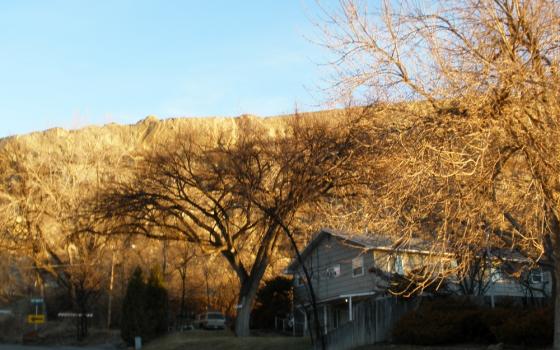Four Gospel insights for addressing climate change
It’s meditation time. I sit at my wide window, candle lit, a braid of sweet grass smoldering. Sunrise, pink, magenta and glare of gold across a big sky, bronzes Eagle Sandstone cliffs that tower above my Billings, Montana, home. Laid down during the Late Cretaceous, 100 to 66 million years ago in the heyday of the dinosaurs, the massive cliffs appear to be the remains of a long barrier island that stood between a coastal lagoon and the shallow inland sea that flooded most of North America during that time.
Today, dawn is flung from that barrier island into my home and heart.
I know that the Earth community stands on the brink of another ending, the end of the Cenozoic, heyday of flowers, birds, mammals and, recently, humans. I am pondering a sacred scripture, wisdom laid down a mere two thousand years ago: Jesus’ parable of the fig tree (Luke 13:6-9). Can this wisdom stand as a barrier to the destruction increasingly caused by industrialized, militarized, human societies on a rampage of fossil-fuel burning? Better yet, can it inspire a new human-Earth harmony?
I think so.
The economically savvy vineyard owner instructs his hired vinedresser to cut down the unproductive fig tree. It’s taking up valuable garden space and gulping scarce water. “Wait,” says the vinedresser who respects the fig tree.
Straight from the vinedresser to us, step one in God’s Action Plan for a flourishing Earth Community: Stand up and stop the destruction.
This is not easy. It requires steady, long-haul, nonviolent resistance to violence against Earth. It means solidarity with people who live near toxic waste dumps or vast oil and gas fracking sites, with families living downstream from the chemical run-off of factory farms or the horror of oil “spills.” It demands speaking an inconvenient truth about our ruinous addiction to fossil fuels.
And it demands providing positive, Earth healing alternatives. Jesus, the parable teller, does just that. He’s observed farmers carefully.
“Let me dig around the fig tree, water it, apply some manure,” suggests the vinedresser. Step two: Learn how Earth works and follow that. Apply Earth’s methods to how we do transportation, home heating and cooling, agriculture and health care.
Design vehicles that glide through air like fish through water, running on solar powered cells. Create buildings that generate more energy than they use, and that recycle the wastes they generate. Plant seasonal gardens. This is known as biomimicry.
“Now, let’s give the fig tree some time. Wait a year,” says the vinedresser. Ah ha! Don’t be in a rush. Step three: Embrace the pace at which Earth does things.
I reach into my prayer basket for a version of the 23rd Psalm from Japan. There are few, if any, herds of sheep in Japan. In Wyoming a cowboy preacher called the Lord “my buckaroo.”
“Lord, You are my pacesetter, I shall not rush. You make me stop for quiet intervals, providing me with images of stillness which restore my serenity. You lead me in the way of efficiency through calmness of mind. You guide me in peace. Your timelessness keeps me in balance. You anoint me with oils of tranquility.” Gracious instructions for how to give the fig tree of Earth, and our soulful creativity, time to heal and regenerate.
In due time, enjoy the nourishing figs.
Jesus’ listeners, familiar with the kings and prophets of Israel, see a crowd of images around a fig tree as they hear the parable. In 1 Kings, the peace and security of Judah and Israel is described as each family enjoying their vine and fig tree (4:25). In Zechariah, the people are told to invite each other to “come under your vine and your fig tree” (3:10). Inherent to this idyllic imagery is a scrupulous economic system of just distribution of land, goods and labor, as well as adequate food for all, shared. The story of Jesus feeding the crowd of thousands is evoked. Equitable economic systems are the rock solid foundation for a flourishing Earth and peace among all peoples.
Step four in God’s Action Plan: create equitable economic systems.
The Fig Tree. This humble image of God’s stalwart shalom for the whole Earth community energizes us. It sweetens our aching efforts for just distribution of Earth’s goodness. It strengthens us as we work to transform massive, entrenched unjust systems into local, resilient communities that flourish by guaranteeing our rights to housing, food, water, education and meaningful work. And, developing economic systems from that. We feel at home as vinedressers.
And who is Jesus’ vinedresser? “My Father,” he says. (Jn 15:9)
I step through my front door into sunset. The cliffs are aglow. I hear a scream and look up in time to catch glimpse of a pair of red-tailed hawks in a glide beneath them. No need for candles. Light everywhere.
[An Oldenburg Franciscan Sister since 1963, Marya Grathwohl lived for more than 30 years in African American, Crow and Northern Cheyenne communities, as teacher, principal and pastoral minister. She is the founding director of Earth Hope, and works in environmental restoration through farming, restoration and other ecology projects.]


